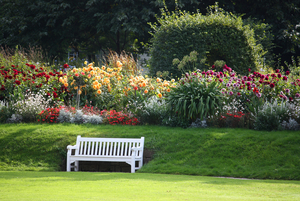If you are anything like I was when I first began gardening, you may be tempted to buy an assortment of flowering plants in the colors of the rainbow. Color is after all, the mainstay of the flowerbed. However, the color scheme you choose for your flowerbed affects the overall feel of your garden. Knowing how to use color to create the “feel” of your flower garden is an important step in garden design.
Warm colors: Shades of yellow, orange and red brighten the garden and draw the eye to your desired focal point. They appear closer and make large areas appear smaller. Warm colors sizzle with energy and are ideal for directing the gaze. Use warm colors to liven dull gardens or pull the eye away from undesired features, such as buildings or the neighbor’s junk pile.
Cool Colors. Violet, soft shades of pink, blue and green recede into the landscape making small areas appear larger than they are. These colors give a natural appearance to your garden and promote relaxation and peacefulness.
Complements: Try pairing colors on the opposite sides of the color wheel to enhance the beauty of each. Pair shades of purple and violet with yellow or orange-yellow, blues with orange or red-orange, and greens with red to create a striking display of color. Purple coneflower paired with bright black-eyed Susan creates a profusion of color in midsummer.
Adjacent colors: To create a unified look to your garden, choose colors that are adjacent to others on the color wheel. This includes three or more colors that in shades of the same color, such as lavender, pink-lavender and pink or red, red-orange and orange. Choose your predominant color first and then choose flowers in shades that fall on both sides of that color. The predominant color should be used for your largest or most abundant flowers. Use adjacent colors to broaden the field of color and add interest to your flowerbed.
Neutral colors: Add earth tones – such as brown and olive – and foliage or flowers in shades of white, gray or black to highlight colors in your flowerbed. This includes large plants as backdrops for your bed, as well as, smaller mounding plants in the foreground.
Eclectic: I like to call my earlier flower gardens eclectic, and I suppose they were. They included a variety of flowers in whatever color struck my fancy, without regard to adjacent plants. If this style appeals to you as much as it secretly calls to me – by all means, go with your natural instincts and choose flowers and plants that you prefer. Remember, accidental combinations often inspire the viewer to try out something new on their own.
More work by this author:
Moon Gardens: Designing and Planting
Balcony Gardens Add Color and Style
Five Old-Fashioned Favorites for the Flower Garden




